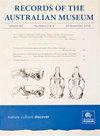Characterizing environmental change and species’ histories from stratified faunal records in southeastern Australia: a regional review and a case study for the early to middle Holocene
IF 0.8
4区 生物学
Q4 ZOOLOGY
引用次数: 3
Abstract
We explore the potential contribution of faunal assemblages from the Australian Alps and surrounding regions towards the characterization of climate and landscape change, and for geochronological species distribution mapping. The limitations of existing faunal sites and collections—their rarity, their stratigraphic integrity and resolution, and accurate dating of their histories—are discussed in a regional review of known and potential assemblages and locations. We also revisit a faunal sequence from a stratified cave deposit at Wee Jasper, focusing on a Holocene “climatic optimum” phase. A suite of species fluctuations between 8000 and 6000 cal. BP suggests responses to local changes such as a warmer and possibly moister environment, with probable associated vegetation shifts. For example, eucalypt forests had replaced more open communities across the region by 8600 cal. BP, and were generally dominant until after 6000 cal. BP. Several faunal species are examined in a regional context using available chronologically defined species histories. Emerging robust multi-proxy investigations demonstrate the potential of faunal assemblages for the development of geographically detailed histories of species that can provide indications of palaeoenvironments. This approach can be strengthened by increasing resolution and developing improved age models in presently known fauna-bearing sites.从澳大利亚东南部的分层动物记录中描述环境变化和物种历史:全新世早期至中期的区域回顾和案例研究
我们探索了澳大利亚阿尔卑斯山及周边地区动物群落对气候和景观变化特征的潜在贡献,以及对地质年代物种分布图的潜在贡献。在对已知和潜在的组合和位置进行区域审查时,讨论了现有动物群遗址和藏品的局限性——它们的稀有性、地层完整性和分辨率,以及它们历史的准确年代测定。我们还重新审视了Wee Jasper分层洞穴沉积物的动物群序列,重点关注全新世的“气候最佳”阶段。8000至6000卡之间的一系列物种波动。BP表明,它们对当地变化的反应,如温暖和可能潮湿的环境,以及可能相关的植被变化。例如,通过8600卡BP,桉树林已经取代了整个地区更开放的群落,并且在6000卡BP之后一直占主导地位。使用可用的按时间顺序定义的物种历史,在区域背景下对几种动物群物种进行了检查。新兴的有力的多代理调查表明,动物群组合在发展物种地理详细历史方面具有潜力,可以提供古环境的指示。这种方法可以通过提高分辨率和在目前已知的动物栖息地开发改进的年龄模型来加强。
本文章由计算机程序翻译,如有差异,请以英文原文为准。
求助全文
约1分钟内获得全文
求助全文
来源期刊
CiteScore
0.90
自引率
0.00%
发文量
9
审稿时长
>12 weeks
期刊介绍:
Records of the Australian Museum, volume 62 was published in 2010, volume 63 in 2011. Monographic works of particular significance are published irregularly as Records of the Australian Museum, Supplements (ISSN 0812-7387).

 求助内容:
求助内容: 应助结果提醒方式:
应助结果提醒方式:


